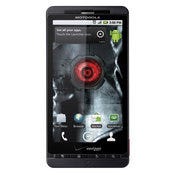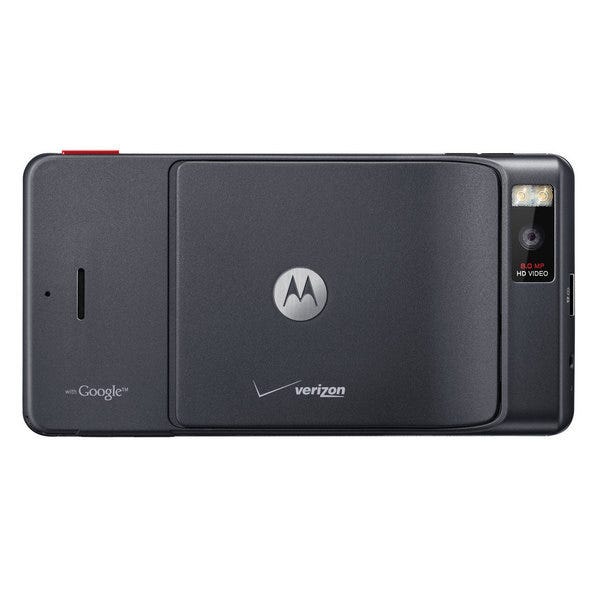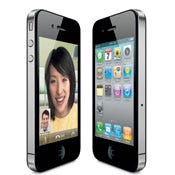Smartphone Death Match: iPhone 4 Versus Droid XSmartphone Death Match: iPhone 4 Versus Droid X
Our mobile expert pits the Apple iPhone 4 against the Motorola Droid X to name the better enterprise smartphone.


Motorola Droid X
(click image for larger view)
Motorola Droid X
Two of the hottest phones of the summer of 2010 are the Apple iPhone 4 and the Motorola Droid X. Are these two phones ready to take on the enterprise? Find out which will be better for your employees to take on the road in information's head-to-head battle.
First, let's define the criteria. Worthy business smartphones need to have excellent battery life, solid phone performance (including a good speakerphone), enterprise e-mail/contacts/calendar support, and proper security protocols. Above and beyond the basics, employers should consider factors such as availability of enterprise applications, browser performance, and potential extra costs associated with the device.
Is Anybody Out There?
As much as we like to send e-mails, texts, IMs, and Tweets, most mobile professionals still conduct a fair amount of business over the phone. That means a business smartphone needs to work well for voice calls.
Features are similar on both phones. They each allow users to dial calls on software keypads or directly from contact lists. They can each make calls from phone numbers embedded in e-mails and Web sites, as well as add a third line to an ongoing call. The iPhone 4 has a slight advantage in that it can also surf the Web during phone calls. The Droid X can't do that. The iPhone can roam in Europe and Asia, meaning employees can use their phone and their number when traveling. The Droid X cannot.
The quality of phone calls made with the Droid X were as good as any I've made on a phone using Verizon's network. Voices in the earpiece were muffled from time to time, but for the most part, the Droid X fared well. Thankfully, earpiece volume is nice and loud. That means you can hear your colleagues and clients even when riding in a car. In a month of testing, the Droid X has yet to drop a call. The speakerphone also did a fine job, and was sufficiently loud enough to be used in a small conference room.
With "antennagate" still fresh in everyone's mind, it is worth pointing out that the iPhone 4 does perform better than the iPhone 3GS when it comes to call quality, sound, and the speakerphone. Apple reported that the iPhone 4 does tend to drop more calls than the iPhone 3GS, however. In the few weeks that I've used the iPhone 4, it has dropped a handful of calls. The iPhone 4 uses two microphones for noise cancellation, and the trick works. Earpiece volume is just barely loud enough, but the reduced background din makes up for it. The speakerphone has also improved noticeably over the iPhone 3GS. It is louder, and clearer.
The problem is, we're comparing the iPhone 4 to the Droid X. When it comes to all-around phone quality, the Droid X easily outpaces the iPhone 4 in call performance.
Image Gallery: Apple iPhone 4, A True Teardown |
|---|
We Can Last Forever
Smartphone battery life is important. Busy professionals need a phone that will make it through at least one day -- and I'm talking a 6 a.m. to 11 p.m. kinda day, not the old nine-to-five.
The Droid X has a rated talk time of 8 hours and 220 hours of standby. Does it live up to those claims? Yes, in fact, it does. In one test call, the Droid X lasted 8 hours and 11 minutes. How does that translate into real-world usage? The Droid X easily lasted two full working days. That included voice calls, Gmail (via Exchange), Twitter, Facebook, browsing, and using the camera. The Droid X's battery life truly impresses -- especially for an Android device.
The iPhone 4 boasts the best battery life of any iPhone to date. Apple rates its talk time at 7 hours, and standby time at 300 hours. In my tests, I was able to eke out a call lasting 6 hours 53 minutes. That's close enough for me. In terms of real-world use, the iPhone 4 has no trouble lasting a full 18-hour work day while leaving enough of a charge to get through half of the next day.
Since most professionals will charge their phone every night, I'd call this about even, though the Droid X has a very slight edge.
Party On The Enterprise
Both the iPhone 4 and the Droid X support basic Microsoft Exchange features. That means they can sync business e-mail, contacts, and calendar information with no problems. Each handles the applications slightly differently, but that isn't too much of a concern for IT. What really matters is security.
If you live by Gartner's recommendations, the iPhone 4 is a "go," and the Droid X is a "no." Gartner's rules for smartphones in the enterprise have a few key requirements. Those two minimums are the ability to remotely wipe the device, and the ability to set complex passwords. Android 2.2 supports those features, but Android 2.1 does not. The Droid X is currently shipping with Android 2.1, though Verizon Wireless and Motorola have promised that the device will be updated to Android 2.2 "soon."
Until it does, Gartner won't recommend any Android 2.1 device. "It appears from what they've announced that Android 2.2 is ready for the enterprise," said Ken Dulaney, VP of mobile computing with Gartner. "Android 2.2 now meets the requirements through Exchange ActiveSync." Launching with Android 2.1 out of the gate will definitely slow enterprise adoption of the Droid X. The sooner Verizon and Motorola can update it to Android 2.2, the better.
The iPhone 4 does support remote wipe, remote locking, and complex passwords. In this category, the iPhone 4 edges out the Droid X.

Motorola Droid X
(click image for larger view)
Motorola Droid X
Application Situation
What else is there to consider? Application availability is one. Both Apple's iOS and Google's Android platforms have a healthy selection of available applications -- more than 300,000 between the two of them. Business and productivity apps are plentiful.
Apple has created a new enterprise developer program, though not all businesses may apply. According to Apple, the iPhone Enterprise Developer Program will let businesses "deploy proprietary, in-house applications to authorized users in your company." The catch? Your company has to have more than 500 employees, and your business has to have a registered Dun & Bradstreet number. Run a small business? Too bad.'For larger organizations, however, Apple's business developer program appears to be fairly robust.'Enterprise app writers can also develop for Android handsets, which support non-market applications to be installed.
Android 2.2 has a device policy manager. Google says the new device policy management application programming interfaces allow developers to write "device administrator" applications that can control security features of the device, such as the minimum password strength, data wipe, and so on. Users can select the administrators that are enabled on their devices.
Usability
Many other features shared by both devices cancel one another out. Both have good browsers, good messaging applications, good displays, and good cameras. They each can record video at 720p. The iPhone is better at syncing and playing back media content, but the Droid X has HDMI out and DLNA software on board to more easily share HD video.
The Droid X runs software from Motorola that was culled from its Motoblur service. When integrated with Android 2.1, the end result is a little chaotic. Screen transitions can sometimes be herky-jerky, applications sometimes pause before opening, and I've had more than my fair share of app crashes. But, it offers a lot of flexibility, a lot of customization features, and the 4.3-inch display means users have tons of real estate to enjoy.
iOS4 from Apple is the best platform software available on the iPhone so far. The new multitasking support -- while still limited -- is a big help when it comes to running some apps concurrently (the new version of Skype, for example). The added unified e-mail inbox is a nice touch, as is support for folders. It is also very stable.
In terms of the hardware, the iPhone is smaller and more pocket friendly. It isn't very durable, however, as a number of users have cracked the glass front and/or back surfaces with drops as short as 10 inches. The Droid X is a huge device, and despite its thin waist-line, is somewhat awkward to store in a pocket. The Droid X doesn't have a glass back, and I've already dropped it several times from three feet with no adverse affects.
 And the Winner Is...
And the Winner Is...
The iPhone 4 and Droid X are well matched. Each offers distinct advantages over its rival. The Droid X beats the iPhone 4 when it comes to phone and call performance, dropped calls, battery life, and enterprise application support. The iPhone 4 surpasses the Droid X when it comes to enterprise security and general usability.
Even though the Droid X does better at many of the essentials, it fails on the most important factor: security. If you're looking to deploy either of these devices in your enterprise right now, the iPhone 4 wins -- but only until the Droid X is updated to Android 2.2. Once the Droid X receives Android 2.2, it will match the iPhone 4 in security and enterprise features.
Rather than deploy now and worry about security later, I'd recommend that any business interested in the Droid X wait until the device ships with Android 2.2 out of the box. It should only be a month or two at most. If you can wait that long, the Droid X is the better phone to choose.
For Further Reading
Droid X A Hit, Orders Pushed To August
Apple iPhone 4 Teardown Reveals $188 In Materials
Editor's note: An explanation of iPhone enterprise apps developed in-house was corrected.
About the Author
You May Also Like






